Search Results for 'homas'
Did you find what you wanted ?
Sun 7 Apr 2024
Posted by Steve under
Reviews[7] Comments
REVIEWED BY DAN STUMPF:
THOMAS STERLING – Murder in Venice. Dell D270, paperback, 1958. Originally published in the as The Evil of the Day (Gollance Ltd, hardcover, 1955; Simon & Schuster, US, hardcover, 1955). Filmed as The Honey Pot (1967), with Rex Harrison. (See also the comments below, which also include information about a play based on the book that preceded the film, plus a link to the book’s Wikipedia page.)

A mid-1950s mystery based on a 17th century comedy, and a plot that sneaks up on you.
For most of its length, Murder in Venice is a light-hearted and pleasantly venomous re-working of Ben Jonson’s Volpone, as a rich-and-dying old man invites a few well-off friends to brighten his last days while he makes up his mind who to leave his money to. Naturally, with an inducement like that, they come a-sailing up to his doorstep (This is Venice, after all.) bearing gifts and greed. And a whole lot of ill-will towards each other, especially when one of them announces that she was the common-law wife of the near-deceased (whose name happens to be Fox, just to reinforce the Volpone connection) and she intends to inherit or at least muddy as anyone else’s claim if she’s not mentioned in the will.
I’ll give you one guess who gets murdered, and as many guesses as you’d like as to whodunit: The rich-looking but broke barrister Voltan, the miserly hypocrite Sims, the not-really-dying Fox, his actor-secretary-stage manager William, the ex-wife’s much-abused paid companion Celia, the butler…
You may even guess right, but I didn’t.
Sterling’s prose is clear and uncluttered, his characters well-rounded but not overblown, and his Venice colorfully evoked in a few verbal brush strokes. But what really impressed me here was the ingenious plotting, which transforms Murder in Venice from a slavish take-off of a literary classic into a classic mystery. Check it out!
Tue 25 Jul 2023
A 1001 MIDNIGHTS Review
by Bill Pronzini

THOMAS B. DEWEY – A Sad Song Singing. Mac #10. Simon & Schuster, hardcover, 1963. Pocket, paperback, 1965. Carroll & Graf, paperback, 1984.
A Sad Song Singing is Mac’s finest case and Dewey’s masterwork. This reviewer considers it one of the ten best private-eye novels ever written — not because of its plot, which is relatively simple and straightforward, but because of its emotional depth and impact and its superb depiction of what it was like to grow up in the early 1960s.
It is the only mystery novel to employ as its background the short-lived hootenanny craze of that period (hootenannies being, for those of you who might have forgotten or are too young to remember, large gatherings at which folk singers entertained with audience participation).
In fact, one can’t imagine any kind of novel more vividly or poignantly evoking that type of festival or the life-styles of its young performers.
Crescentia Fanio, twenty years old and a budding singer, hires Mac to find her missing boyfriend, Richie Darden, himself an itinerant but already well-established singer of folk songs. But it isn’t just a simple case of boy losing interest in girl and leaving her behind; Cress is convinced that not only is Richie’s life in danger, but so is her own.

If Mac has any doubts that her fears are genuine, he quickly loses them with the appearance of two toughs who are unmistakably hunting Darden — and a mysterious suitcase he had with him when he vanished. A combination of flight, chase, and personal odyssey leads Mac and Cress from Chicago into rural Illinois and Indiana, from the world of coffeehouses and hootenannies to an isolated farm near the small agricultural community of Fairmont, Indiana — and finally to tragedy and, for Cress, rebirth.
There is plenty of action and suspense, but as in most of Dewey’s novels — and even more so here — the emphasis is on mood and characterization. The father-daughter relationship between Mac and Cress is what gives the novel its emotional power: The last page is the kind of stuff that could put a tear in the eye of Mike Hammer. In all respects, A Sad Song Singing is a virtuoso performance.
Mac appears in a total of sixteen novels, beginning with Draw the Curtain Close (1947). The others are likewise first-rate, the most notable among them being The Mean Streets (1954), the novel in which Mac — and Dewey — realized his full potential (thus making the title, a phrase from Chandler’s essay “The Simple Art of Murder,” doubly appropriate); The Brave, Bad Girls (1956), The Case of the Chased and the Unchaste (1959), Don’t Cry for Long (1964), Portrait of a Dead Heiress (1965), and The King Killers ( 1968).

Dewey also wrote four minor mysteries featuring a small-town hotel owner named Singer Batts, the best of which are probably As Good as Dead (1946) and Handle with Fear ( 1951 ). Of his non-series suspense novels, two arc first-rate:
How Hard to Kill (1961), a chiller about an ex-cop’s hunt for the murderer of his wife; and the paperback original A Season for Violence (1966), which is concerned with corruption, murder, and rape in a small California town.
———
Reprinted with permission from 1001 Midnights, edited by Bill Pronzini & Marcia Muller and published by The Battered Silicon Dispatch Box, 2007. Copyright © 1986, 2007 by the Pronzini-Muller Family Trust.
Tue 11 Jul 2023
A 1001 MIDNIGHTS Review
by Bill Pronzini
THOMAS B. DEWEY – Only on Tuesdays. Pete Schofield #8. Dell 6680, paperback original, 1964.
In addition to the “Mac” series, Dewey also created another private eye, Los Angeles-based Pete Schofield, for a series of paperback originals in the Fifties and early Sixties. The Schofield novels are much lighter in tone, much sexier (as sexy as paperback mysteries could get in that era, anyhow), and lacking the depth and quality of the Mac novels.
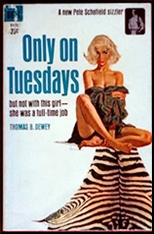
Schofield, who is married to a sultry lady named Jeannie (married private eyes never seem to work out well in fiction), is something of a bumbler and spends as much time trying to crawl into the sack with Jeannie as he does solving crimes. But things keep happening to prevent his connubial bliss — telephone calls, people showing up at highly inopportune moments, squabbles, battle wounds, and various other interventions.
Dewey’s technical skill and sense of humor make this sort of thing work: The Schofield books are exactly what they were intended to be-pleasant light reading — and no more.
Only on Tuesdays, perhaps the best of the series, begins when Pete comes home after a hard day and finds an unemployed actor holding a gun on Jeannie; he also finds. not irrelevantly, a new addition to the family (a dachshund, Hildy) hidden away in the bedroom closet.
It ends with a frantic sailboat race to Catalina Island and another confrontation in the Schofield domicile, this time with a murderer. In between he encounters a missing wife, a wealthy yachtsman named Conway, some highly compromising photographs, and of course plenty of murder and mayhem. The sailing scenes are genuinely exciting and suspenseful, and the byplay between Pete and Jeannie, which in some of the other books becomes a bit tedious, is restrained and amusing.
All the Schoficlds are worth reading; along with Only on Tuesdays, the best of them are Go to Sleep, Jeannie (1959), Too Hot for Hawaii (1960), and The Girl with the Sweet Plump Knees (1963).
———
Reprinted with permission from 1001 Midnights, edited by Bill Pronzini & Marcia Muller and published by The Battered Silicon Dispatch Box, 2007. Copyright © 1986, 2007 by the Pronzini-Muller Family Trust.
The Pete Schofield series —
1. And Where She Stops (1957)
2. Go to Sleep, Jeanie (1959)
3. Too Hot for Hawaii (1960)
4. The Golden Hooligan (1961)
5. Go, Honey Lou (1962)
6. The Girl with the Sweet Plump Knees (1963)
7. The Girl in the Punchbowl (1964)
8. Only On Tuesdays (1964)
9. Nude in Nevada (1965)
Wed 5 Jul 2023
A 1001 MIDNIGHTS Review
by Bill Pronzini
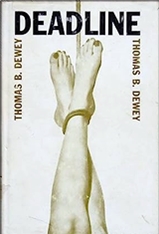
THOMAS B. DEWEY – Deadline. Mac #13. Simon & Schuster, hardcover, 1966. Pocket 55002, paperback, 1968. Carroll & Graf, paperback, 1984. Probably condensed and reprinted as the story “Deadline†appearing in Sir!, August 1968 [see Comment #6].
Thomas B. Dewey is one of detective fiction’s severely underrated writers — a craftsman of no small talent whose work is among the most human and compassionate of any in the genre. Although Dewey was clearly influenced by Hammell and Chandler, his Chicago-based private eye, “Mac,” is not one of the wisecracking, vigilante breed of fictional ops; he is intelligent, quiet, gentle, ironic, tough when he has to be, a light drinker, and a man not incapable of being hurt either physically or emotionally. All in all, a far more likable creation than the bulk of his brethren.
In Deadline. Mae is hired by a group of do-gooders in a last-ditch effort to save the life of a small-town youth, Peter Davidian, who has been convicted of the mutilation murder of an eighteen-year-old girl and is awaiting execution in the state prison. When Mac arrives in the rural Illinois town, Wesley, he meets considerable hostility: The crime was a particularly vicious one, and the girl’s father, Jack Parrish, is an influential citizen who is convinced of Davidian’s guilt.
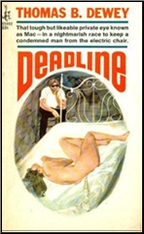
Racing against time-he has only four days before the scheduled execution, the “deadline” of the title- Mac utilizes the aid of a retarded handyman, a friend of the dead girl’s named Mary Carpenter, and a schoolteacher named Caroline Adams to find out who really murdered Esther Parrish. In the process he has to overcome a conspiracy of silence, threats, and a harrowing brush with death.
This is a simple, straightforward story, told with irony, fine attention to detail, and mounting suspense. Satisfying and memorable.
———
Reprinted with permission from 1001 Midnights, edited by Bill Pronzini & Marcia Muller and published by The Battered Silicon Dispatch Box, 2007. Copyright © 1986, 2007 by the Pronzini-Muller Family Trust.
Sat 29 Apr 2023
THOMAS M. DISCH “Voices of the Kill.†First published in Full Spectrum, edited by Lou Aronica & Shawna McCarthy (Bantam Spectra, paperback original, September 1988). Reprinted in The Year’s Best Fantasy: Second Annual Collection, edited by Ellen Datlow & Terri Windling (St. Martin’s Press, trade paperback, 1989). Collected in The Wall of America (Tachyon, softcover, 2008).

Thomas M. Disch was an author almost as well-known for his poetry as he was for his unique blend of science fiction and fantasy. While “Voices of the Kill†is a fantasy tale through and through, it is poetry as well, and in a way as opaque to me as most poetry is.
It is the story of a man who, living alone in a cabin along a stream, falls in love (of sorts) with the flowing water, or (perhaps better said) is seduced by the stream, lying at night as he does in its waters and soothing embrace, listening to it talk to him.
I do not know why Nixie asks him to place a twenty dollar bill under a stone in its (her?) depths. When William’s cousin Barry comes to visit, the overnight stays in the stream must end. When the two travel down it to its outlet into the sea, Nixie is annoyed.
And what is the significance of the black woman in a pea-green swimsuit who is playing there with her son on the beach? (She does return.)
In spite of these and other questions I cannot answer, the effect of this story is one I cannot get out of my head. Good poetry (and fantasy) can have an amazing effect on one’s mind. It is no wonder this was the lead story in the Full Spectrum anthology where it first appeared.
Fri 13 Jan 2023
Posted by Steve under
Reviews[8] Comments

THOMAS B. DEWEY – Death and Taxes. Mac #14. G. P. Putnam’s Sons, hardcover, 1967. Berkley, paperback, May 1968.
This one starts out the way a good old-fashioned PI story should – no, I’ll take that back. Any good PI story should start with a good-looking blonde entering the PI’s office as a would-be client. But consider this as the next best thing:
They shot Marco Paul on June 18 at 2:15 in the morning, in an alley behind a place called Ezra’s on the Northeast Side.
Given that Marco Paul having been an old-fashioned Chicago gangster for most of his life, and this is an old-fashioned hit straight out of Black Mask Magazine, you might even decide that this is a better first sentence than the worn-out Gorgeous Blonde Client Gambit.

And as it turns out, Marco Paul is/was on the verge of becoming Mac’s client. What Paul wanted Mac to do is make sure that his daughter gets the million dollars in cash he has stashed away for her, tax-free.
So far, Mac has said he’d think about it. Does he know where the million dollars is? No. They hadn’t gotten around to that. Do other parties (both friends — some closer than others — and family) think he knows where the million dollars is? Yes, and they become actively involved in finding out where it is.
At one point along the way Mac is severely tortured and beaten. Does he recover in the very next scene and carry on as usual, as a certain detective named Joe Mannix always did after being conked on the head? No. Definitely not. This is real life that Mac is living through, and real life often hurts.
I mentioned Black Mask a short distance upstairs. This reads – or at least the first half does – like a finely tuned Black Mask story, a little more literate and a little more polished, perhaps, and it is a lot of fun to read. Unfortunately when it comes time to pull all of the plot threads together, Death and Taxes becomes a lot more standard type of PI tale, with lots of guns blazing away and a lengthy explanation of who did what to whom and when.
I going to call it a mixed bag, then, and let you decide, once you take me up on this proposition, to read this for yourself and tell me which half you preferred.
Mon 21 Nov 2022
Posted by Steve under
Reviews[4] Comments
REVIEWED BY TONY BAER:
ROSS THOMAS – Chinaman’s Chance. Arthur Case Wu & Quincy Durrant #1. Simon & Schuster, hardcover, 1978. Avon, paperback, 1979. Mysterious Press, paperback, 1988.
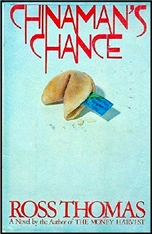
A few years ago some dude named Malcolm Jones (who I’ve never heard of) shared his top ten list of crime novels. All the ones I’d already read were great, lending the list some credibility. The ones I hadn’t have been great too. Chinaman’s Chance made the grade. So I was impelled to try it out.
A ramshackle ramble by the seat of its pants, the story is an entertainment. A wonderful entertainment. And of perhaps all the novels I’ve ever read, it deserves that moniker. It strives to be nothing other than entertainment. And it succeeds. Wonderfully and wonderfully vacuous.
There are so many plot threads that it will be hard to relay them in linear, straightforward fashion. God knows that Thomas didn’t try to do it. And yet it is the multiple perspectives and slowly eked out details that makes the damn thing so tantalizing, anticipated and delicious.
I’ve read that Woody Allen only gives his actors their own lines to remember and they have no idea how the whole script fits together. That’s the feeling you get from the characters here. No one has the whole picture. Everyone has just a little piece. And the story reveals itself like a picture puzzle put together, piece by piece, before your eyes. But this picture puzzle you bought came in a blank cardboard box. So you have no idea ahead of time how the thing is supposed to look.
In fact I’d be surprised if Thomas knew ahead of time how it all was going to fit together. If he did, and outlined it all ahead of writing it, then he’s a freaking genius. If not, then he’s really really lucky. Because all of the pieces in this 5000 piece puzzle fit. Even though it seems like he’s manufacturing the puzzle pieces right before your very eyes.
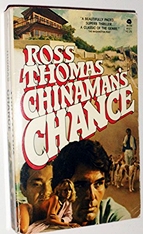
But hey. I’ll have a try at linear summary.
Artie Wu and Quincy Durant are soldiers of fortune. Back when the Vietnam war was petering out, there was money to be made. An associate of theirs at the US Embassy, Reginald Simms, was given orders to burn the 12 million in U.S. currency on hand. He burned 10 million of it.
The other two mil? Simms and his college roommate, a major mafia figure, ‘buy’ the political machinery of the small broken down coastal town of Pelican Bay in Southern California.
The dream? To build a red-light district version of Epcot Center: “[S]in without sorrow and thrills without danger…. You can go from Paris to Berlin…. to Singapore to Hong Kong to Marseilles to London’s Limehouse to San Francisco to New Orleans to New York to wherever you have ever dreamed of going. It will all be within this four block square area, and whatever you have dreamed of finding in those places you will find here — carefully sterilized for safe consumption…. People don’t want the real thing… because the real thing has bad breath, and sweaty armpits, and sometimes steals your wallet and makes you hurt when you pee. What people want is vice and sin that look the way they look in the movies — and that’s exactly what we intend to give them.â€
So what’s wrong with it? Well maybe nothing in principle. But the devil’s in the details. And whether the end justifies the means.
Part of the means involved screwing over Artie Wu and Quincy Durant back in Vietnam. Including getting Durant’s fiancé murdered by the Viet Cong.
And part of cleaning out the old Pelican Bay political machinery involves killing a Congressman opposed to graft. And the Congressman’s wife. And the Congressman’s mistress.
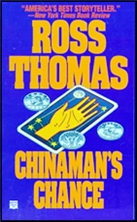
So that’s basically the story. It’s about Artie Wu and Quincy Durant seeking vengeance and a cool $2 million coming up against the mob.
It’s supremely entertaining. And another thing that surprised me is how Tarantinoesque the thing is. And it predates Tarantino by more than a decade. So the phrase shouldn’t be Tarantinoesque. Tarantino is being RossThomaseque. It’s all there: the combination of brutal violence and slapstick comedy.
There are a number of great scenes so it’s hard to pick one to illustrate the point. But my favorite involves a couple of hitmen who’ve taken their target in a Winnebago, intending to throw him off a cliff near Pepperdine University. They lecture the murderee on having made bad career choices. Then they are distracted as it dawns on them that Pepperdine’s campus appears in The Six Million Dollar Man! The murderee leverages their distraction by grabbing a can of gasoline and setting them on fire while the Winnebago flies off a cliff.
So yeah. It’s like that. And if it sounds like your bag, give it a read. It’s a great movie to watch in the theater of your mind. Grab the popcorn.
Thu 25 Aug 2022
Posted by Steve under
Reviews[3] Comments
REVIEWED BY TONY BAER:
THOMAS B. BLACK – The 3-13 Murders. Al Delaney #2. Reynal & Hitchcock, hardcover, 1946. Bestseller Mystery #151, paperback, date? Jonathan Press Mystery, paperback, date?

Al Delaney, a private detective, is hired to clear a bank president of murder when a Jane Doe is found stabbed to death in his home.
The “3-13” in the title refers to the numbers that dealers use to refer to cocaine and morphine. The third letter of the alphabet is ‘C’ for cocaine, and the 13th is ‘M’ for morphine.
There’s a quack of a religious leader, “The Great I-Give†who has a team of proselytizers distributing copies of his religious newspaper through town. For a reason that seems more than just coincidence, a trail of drug addiction and murder follows the same trail as the newspaper distribution of the “The Great I-Giveâ€.
The feds, the cops and Delaney converge with guns a-blazing on the mobsters, the junkies and the religious freaks that have brought mayhem to town.
It’s an enjoyable hardboiled romp with all the trimmings. Another off of James Sandoe’s reliable 1952 hardboiled checklist. at https://thrillingdetective.com/2021/06/22/the-hard-boiled-dick/. The physical copies of the Delaney books are scarce, so I read the book online at https://archive.org/details/313murders00blac.
More at https://thrillingdetective.com/2021/06/25/al-delaney/
and
http://moonlight-detective.blogspot.com/2019/04/the-3-13-murders-1946-by-thomas-b-black.html.
The Al Delaney series —
The Whitebird Murders. Reynal, 1946.
The 3-13 Murders. Reynal, 1946.
The Pinball Murders. Reynal, 1947.
Four Dead Mice. Rinehart, 1954.
Sat 19 Mar 2022
Posted by Steve under
Reviews[7] Comments
THOMAS B. DEWEY – Deadline. Mac #13. Simon & Schuster, hardcover, 1966. Pocket 55002, paperback, 1968. Carroll & Graf, paperback, 1984. Presumably expanded from the short story “Deadline” appearing in Sir!, August 1968.

For a hardboiled PI detective novel, which this one definitely is, it’s a little different from most hardboiled PI novels – but probably not different enough to be unique, one of a kind. Mac – that’s the only name we ever know him by in all 17 of his novels – has been hired by a panel of psychologists and social workers, not to prove a young boy on death row is innocent – he’s already confessed – but to prove that he’s legally insane, and to persuade the governor to issue a stay of execution.
Most of Mac’s cases take place in the down and dirty streets of Chicago. (The second and last two take place in Los Angeles.) Deadline takes place in the small farming community of Wesley, Illinois. Dominating the town is the local John Deere dealer, and since it was his daughter who was brutally murdered, the man most certainly does not want Mac to stop the execution.

Mac does not have much to work with. His “client†is socially challenged and it is difficult for him to give any coherent information about the day of the girl’s killing. Her best friend, still in high school, has an emotional disorder. Mac’s only ally in Wesley is Miss Adams, a teacher in the local high school, and since she is dating the girl’s father, her help is only reluctantly provided at best.
Mac is beaten up at least once in this one, and chained up in a barn so he can’t do any damage to the case against the boy about to be executed. The title, Deadline, is certainly an appropriate one. Mac’s efforts to figure out what exactly did happen come down to the last minute. Somewhat unfortunately, the clue that’s the key one is rather an obvious one. (I spotted it, after all.)
There’s a hint of attraction between Mac and Miss Adams, but it’s clear by book’s end that anything more than that is not going to happen. That’s an ending that quite probably happened to him more than once.
Fri 5 Feb 2021
Posted by Steve under
Reviews[8] Comments
ROSS THOMAS – The Fools in Town Are on Our Side. William Morrow, hardcover, 1970. Avon, paperback, 1972; Mysterious Press, paperback, 1987; St. Martin’s, paperback, 2003.

A long book, 383 pages, most of it about a Poisonville named Swankerton. To clean up a corrupt town, apply Orcutt’s First Law: “To get better, it must get worse.” The crew consists of a crooked ex-cop, an ex-whore, an ex-secret agent named Lucifer Dye, and a boy-wonder boss named Orcutt.
The story is Dye’s, with threads from his past – his boyhood in a Shanghai bordello, his life with Section Two – combining into a full-life portrait. The action is hard, tough, utterly ruthless and ultimately frightening. Corruption is hardly a sufficient word.
After juggling three stories, Thomas finally settles down to the tale of Swankerton. Unfortunately those threads from Dye’s past fizzle out after the long buildup. I don’t believe this has been published yet in paperback, but it might be worth reprinting, pertinent to today’s CIA inquiries – if that piece of action had only been followed up with care.
Rating: B plus.
— Slightly revised from The Mystery Nook, Vol. 2, No. 2 (whole #8), 15 December 1975.
UPDATE: In this review, I wondered why this book has never come out in paperback. The fact was, and I didn’t know it, that it had. I missed it — the Avon paperback from 1972 — nor was I the only one. Very few copies of that edition show up offered for sale today online.
In the comment he left following Dan Stumpf’s recent review of Red Harvest, Sai Shankar asked me if I’d ever reviewed this book. I said I had, but I didn’t know where it was. Lo and behold, here is is.















